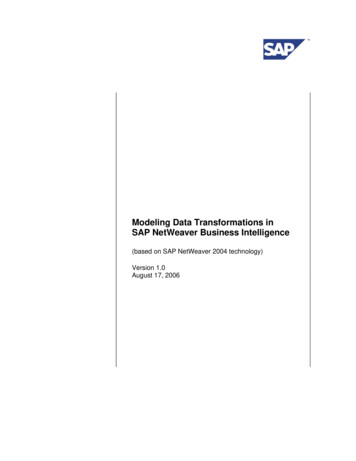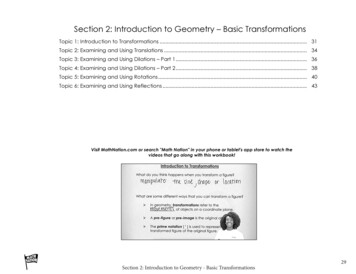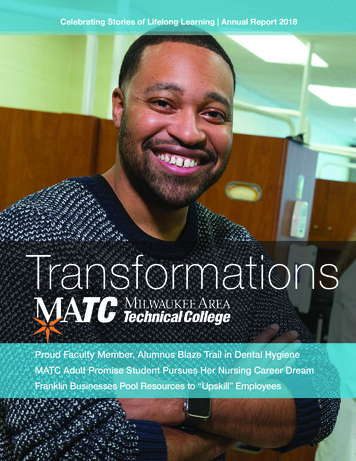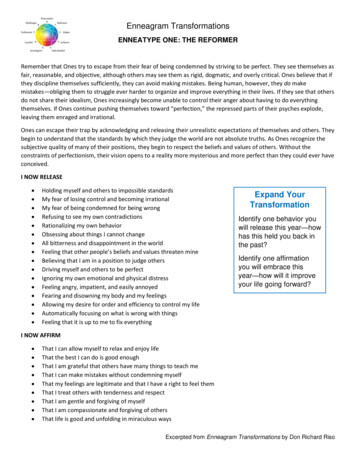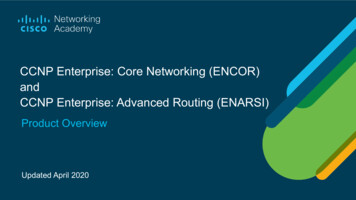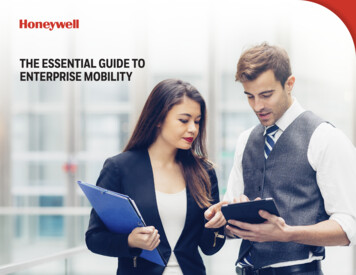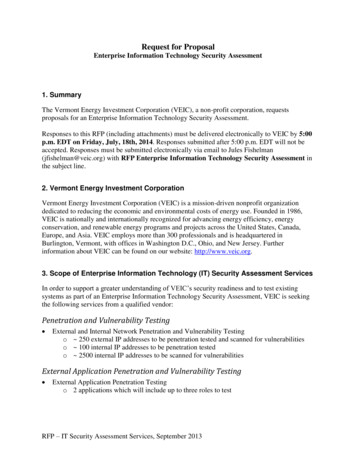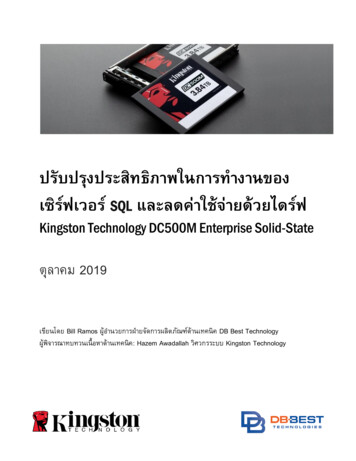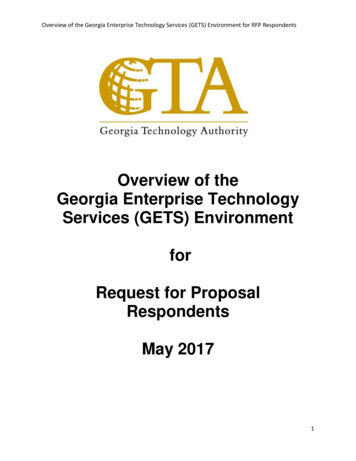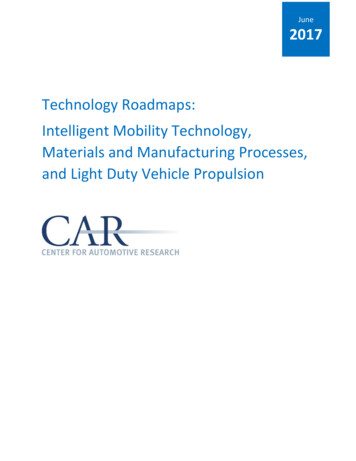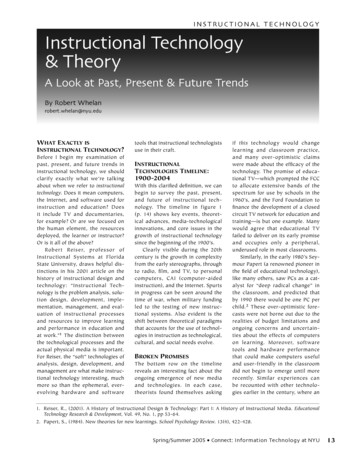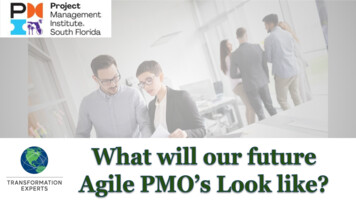
Transcription
Transformation ExpertsRegina Batista is a Strategic Leader with experience implementingTechnology & Business Transformations. An Enterprise Agile Coach, AgileTrainer/Consultant with over 20 years of PMO, Portfolio, Program, Projectmanagement and IT Consulting expertise.Regina BatistaTransformation Experts, adding value to your organizationWe are a professional services company that provides Agile Transformation,Consulting, Coaching, Training, and Staffing solutions. No matter what yourstage of Agile adoption is, just beginning, or if you're ready to take your teamsto the next level, we have solutions to suit your needs.Officially Licensed Material Transformation Experts 2020
AgendaWhat will we learn?1. Define the Portfolio for Scaling Agile Practices2. Organizing the Portfolio around Value3. Explain the need for Lean Portfolio Management4. Apply the Lean-Agile Mindset to Portfolio Management5. Describe key Lean Budgeting practicesOfficially Licensed Material Transformation Experts 2020
1. Define the Portfolio for Scaling AgilePractices
What are some of our current or portfoliomanagement challenges?Officially Licensed Material Transformation Experts 2020
Traditional project portfolio management challenges Traditional project portfolio approachesinhibit the flow of value Project cost accounting Annual planning and rigid budgeting cycles Perpetual overload of demand versuscapacity Phase-gate approval processes that fail tomitigate risk Overly detailed business cases withspeculative ROIOfficially Licensed Material Transformation Experts 2020
Known Scaled Agile Frameworks. Scrum@Scale Scrum@Scale naturally extends the core Scrum framework to deliver better results organization-wide. Scrum@Scale has helped networks of teamsacross industries and disciplines to address complex problems, while creatively delivering products and services of the highest possible value. LeSS (Large-Scale Scrum) LeSS is a framework for scaling agile development to multiple teams. It builds on top of the Scrum principles such as empiricism and cross-functional,self-managing teams and provides a framework for applying that at scale. SAFe (Scaled Agile Framework) SAFe is described as an interactive knowledge base for implementing agile practices at enterprise scale. SAFe provides a lot of guidance, and covers abroad scope including financing and enterprise architecture. SAFe is prescriptive and addresses the enterprise at 3 levels*, team, program and portfolio.At the Team level, SAFe is not that different from Scrum extended with a few XP practices. The Program level aligns the teams around some additionalcommon events to form an Agile Release Train (ART), while the Portfolio level aligns the ART with the strategic goals of the organisation. DA (Disciplined Agile)DA is not a scaling framework per se. It’s a process decision framework that provides a comprehensive guide to everything you need for an Agile transformation. DA utilises Scrum, Kanban, along with transformation knowledge on areas like HR and Finance, Governance, DevOps, PortfolioManagement and Culture. It’s a one stop shop, organised around specific goals that allows you to consider your options and learn about your choices. Nexus Framework Ken Schwaber and Scrum.org developed Nexus, and it is just simply a framework that implements scrum at scale across multiple teams to deliver asingle integrated product. Teams work in a common development environment and are focused on producing a combined increment every sprint withminimal dependencies.Officially Licensed Material Transformation Experts 2020
The world’s leading framework for Enterprise agilityOfficially Licensed Material Transformation Experts 2020
What is a SAFe portfolio? A SAFe portfolio manages multiple development Value Streams,each of which is dedicated to building and supporting a set ofSolutions for a particular business domain or Government agency A portfolio typically represents a specific area of the Enterprise, forexample business units or divisionsOfficially Licensed Material Transformation Experts 2020
Small Enterprises may have a single SAFe portfolioOfficially Licensed Material Transformation Experts 2020
Large Enterprises will have multiple portfoliosIn larger enterprises, there can be multiple SAFe portfolios,typically one for each line of business, business unit, or division.Officially Licensed Material Transformation Experts 2020
Development Value StreamsDevelopment Value Streams provide Solutions for operational Value StreamsOfficially Licensed Material Transformation Experts 2020
2. Organizing the Portfolio around Value
Instead, organize the portfolio around the flow of valueOrganizing the portfolio around value requires the enterprise to: Move from projects toproducts and services Understand what the ValueStreams deliver and how todo value stream mapping Focus on achieving businessoutcomes rather thancompleting tasksOfficially Licensed Material Transformation Experts 2020
Key benefits of organizing the portfolio around valueOfficially Licensed Material Transformation Experts 2020
3. Explain the need for Lean PortfolioManagement
Purpose of the Lean Portfolio Management (LPM) functionThe LPM function governs eachSAFe portfolio, providing threeessential collaborations torealize its responsibilities: Strategy and investmentfunding Agile portfolio operations Lean governanceOfficially Licensed Material Transformation Experts 2020
Traditional project portfolio management challenges Traditional project portfolio approachesinhibit the flow of value Project cost accounting Annual planning and rigid budgeting cycles Perpetual overload of demand versuscapacity Phase-gate approval processes that fail tomitigate risk Overly detailed business cases withspeculative ROIOfficially Licensed Material Transformation Experts 2020
Traditional portfolio approaches vs organizing around valueOfficially Licensed Material Transformation Experts 2020
Project cost accounting vs Lean Budgets and GuardrailsOfficially Licensed Material Transformation Experts 2020
Annual planning and rigid budgeting cycles vs. rolling wave planningOfficially Licensed Material Transformation Experts 2020
Perpetual overload of demand vs. matching demand to capacityOfficially Licensed Material Transformation Experts 2020
Phase-gate approvals vs incremental value deliveryOfficially Licensed Material Transformation Experts 2020
Overly detailed business cases vs Lean business casesOfficially Licensed Material Transformation Experts 2020
4. Apply the Lean-Agile Mindset toPortfolio Management
DurationWhat is a Lean-Agile Mindset?3Officially Licensed Material Transformation Experts 2020
Two primary aspects of a Lean-Agile mindsetOfficially Licensed Material Transformation Experts 2020
Applying the SAFe Lean-Agile Principles to the portfolioOfficially Licensed Material Transformation Experts 2020
Principle #1: Take an economic viewBase decisions on economics to achievebetter business outcomes: Deliver early and often Operate within Lean Budgets andGuardrails Understand economic trade-offs forSolutions Leverage Suppliers Sequence jobs (Epics) for maximumbenefit Empower local decision makingOfficially Licensed Material Transformation Experts 2020
Principle #5: Base milestones on objective evaluation of working systems Build the system inincrements, each of which isan integration point thatdemonstrates someevidence of the feasibility ofthe solution in process. Milestones based onobjective evaluation ofworking systems.Officially Licensed Material Transformation Experts 2020
Activity: Applying SAFe Principle #5 to the portfolio Share52Step 1: Consider the following scenario:– PrepareThe TTC portfolio has invested in a newValue Stream for delivering groceries. Due tochanges in regulations, the phase-gatedprocess requires the teams to revise all therequirements and gain approval beforecontinuing development.Step 2: Discuss as a team and share withthe class:–How would you apply SAFe Principle #5 toimprove portfolio flow?Officially Licensed Material Transformation Experts 2020
Principle #6: Visualize and limit WIP.Lean Enterprises strive to achieve acontinuous flow of value. Three keys toimplementing flow: Visualize and limit the amount of work inprocess (WIP) to match demand to actualcapacity Reduce the batch sizes of work to facilitatea fast and reliable flow through the system Manage queue lengths to reduce the waittimes for new CapabilitiesOfficially Licensed Material Transformation Experts 2020
Reduce batch sizes of work for higher predictabilityFocus on a fast flow of value, not resource utilization.Officially Licensed Material Transformation Experts 2020
Foster decentralized decision-makingOfficially Licensed Material Transformation Experts 2020
5. Describe key Lean Budgeting practices
Key Lean Budgeting practicesBenefits of Lean Budgeting: Lower overhead and higher throughput Create alignment and transparency Foster decentralized decision-making Improved morale Teamwork mindset Better business outcomesOfficially Licensed Material Transformation Experts 2020
Fund Value Streams not projects As part of the enterprise’s total budget, an allocation of peopleand resources is established for each portfolio. The portfolio allocates the budget for each Value Stream.Officially Licensed Material Transformation Experts 2020
Guide investments by horizons of growthOfficially Licensed Material Transformation Experts 2020
Apply participatory budgetingLPM and representatives from different value streams use‘participatory budgeting’ to collaboratively determine which epicsshould be chosen next for implementation.Officially Licensed Material Transformation Experts 2020
DurationWhat is a Lean-Agile Mindset?3Officially Licensed Material Transformation Experts 2020
What did we learn?1. Defined the Portfolio for Scaling Agile Practices2. Organized the Portfolio around Value3. Explained the need for Lean Portfolio Management4. Applied the Lean-Agile Mindset to Portfolio Management5. Described key Lean Budgeting practicesOfficially Licensed Material Transformation Experts 2020
Questions
Thank you!
capacity Phase-gate . SAFe (Scaled Agile Framework) SAFe is described as an interactive knowledge base for implementing agile practices at enterprise scale. SAFe provides a lot of guidance, and covers a broad scope including financing and enterprise architecture. SAFe is prescriptive and addresses the enterprise at 3 levels*, team, program and portfolio. At the Team level, SAFe is not that .
